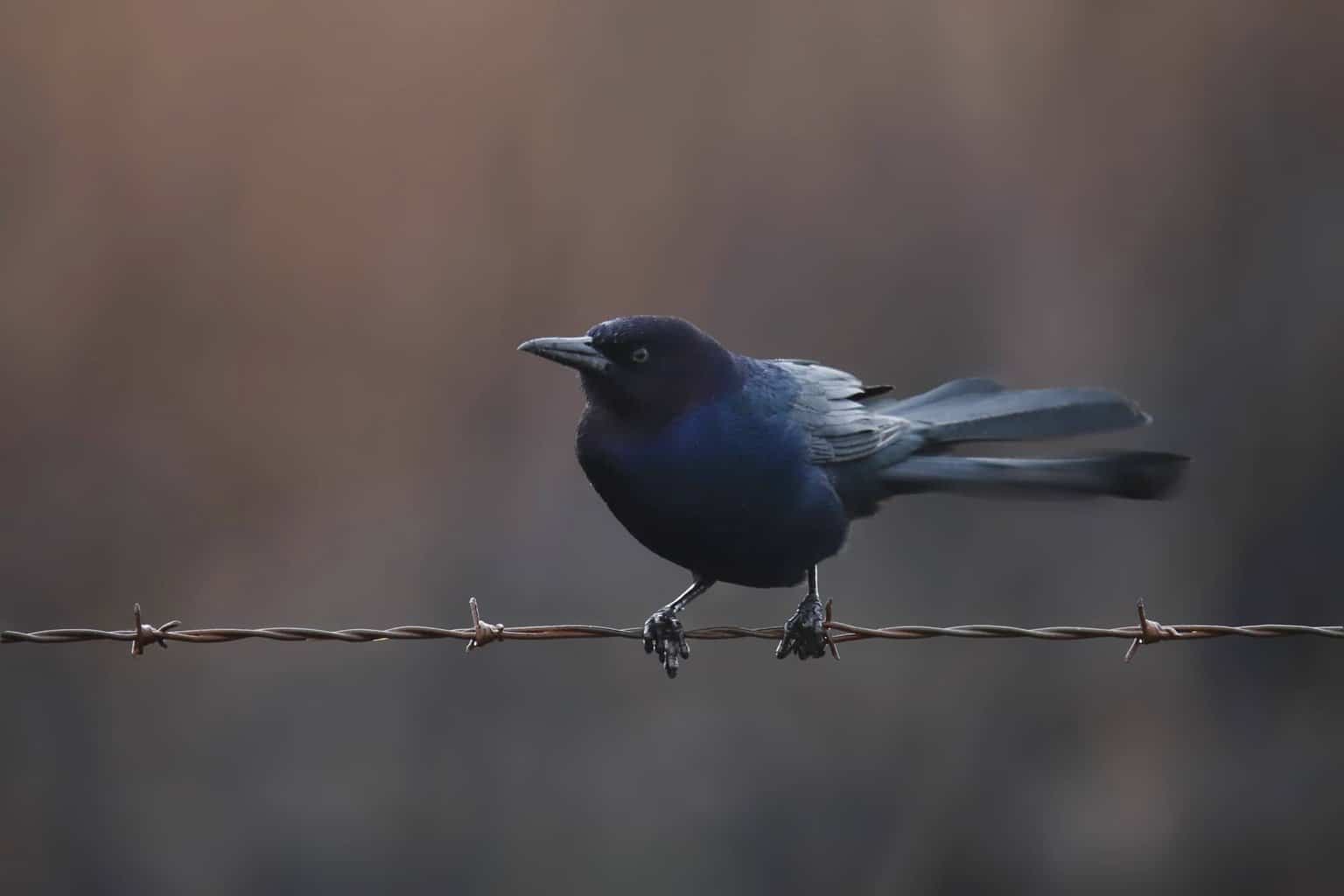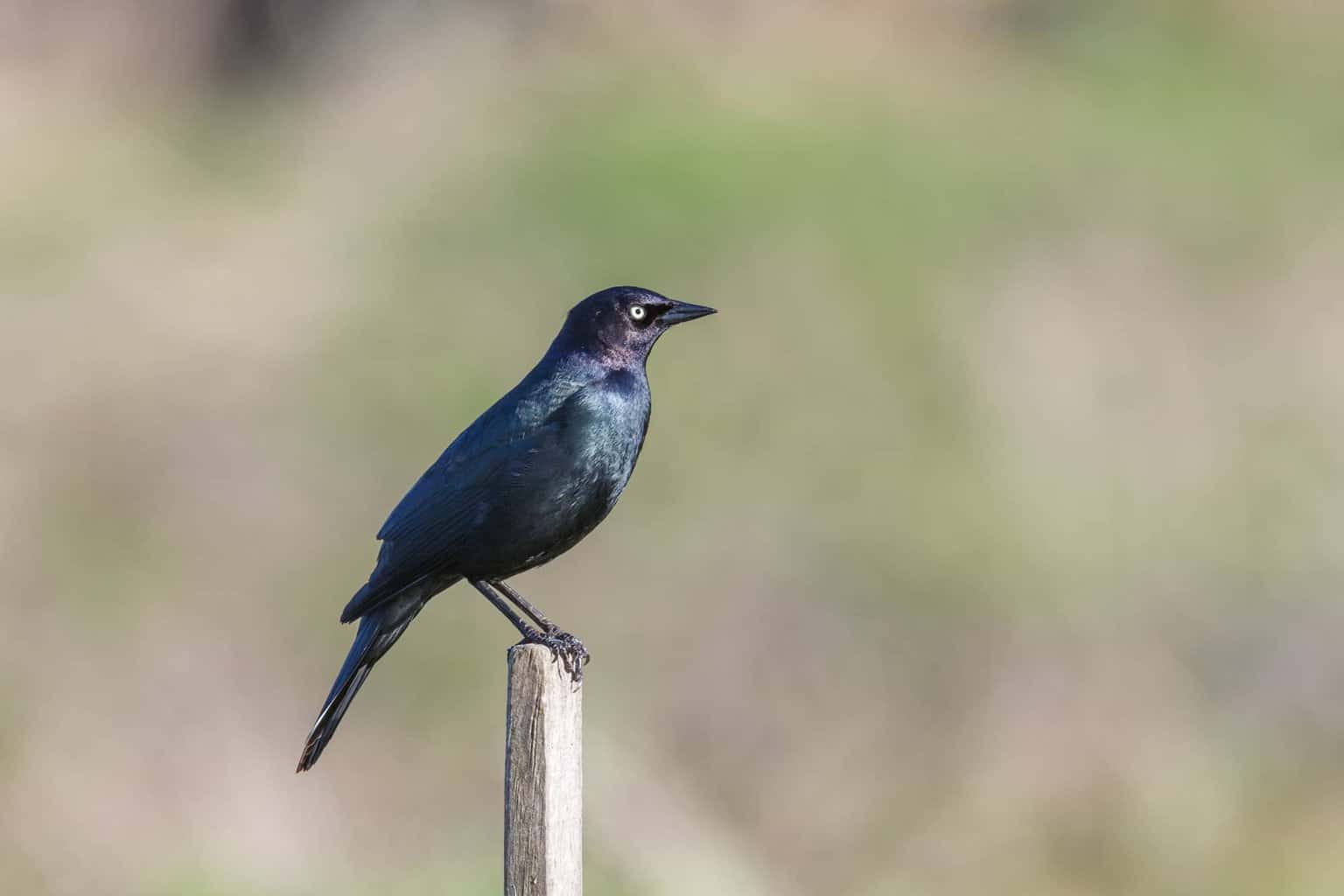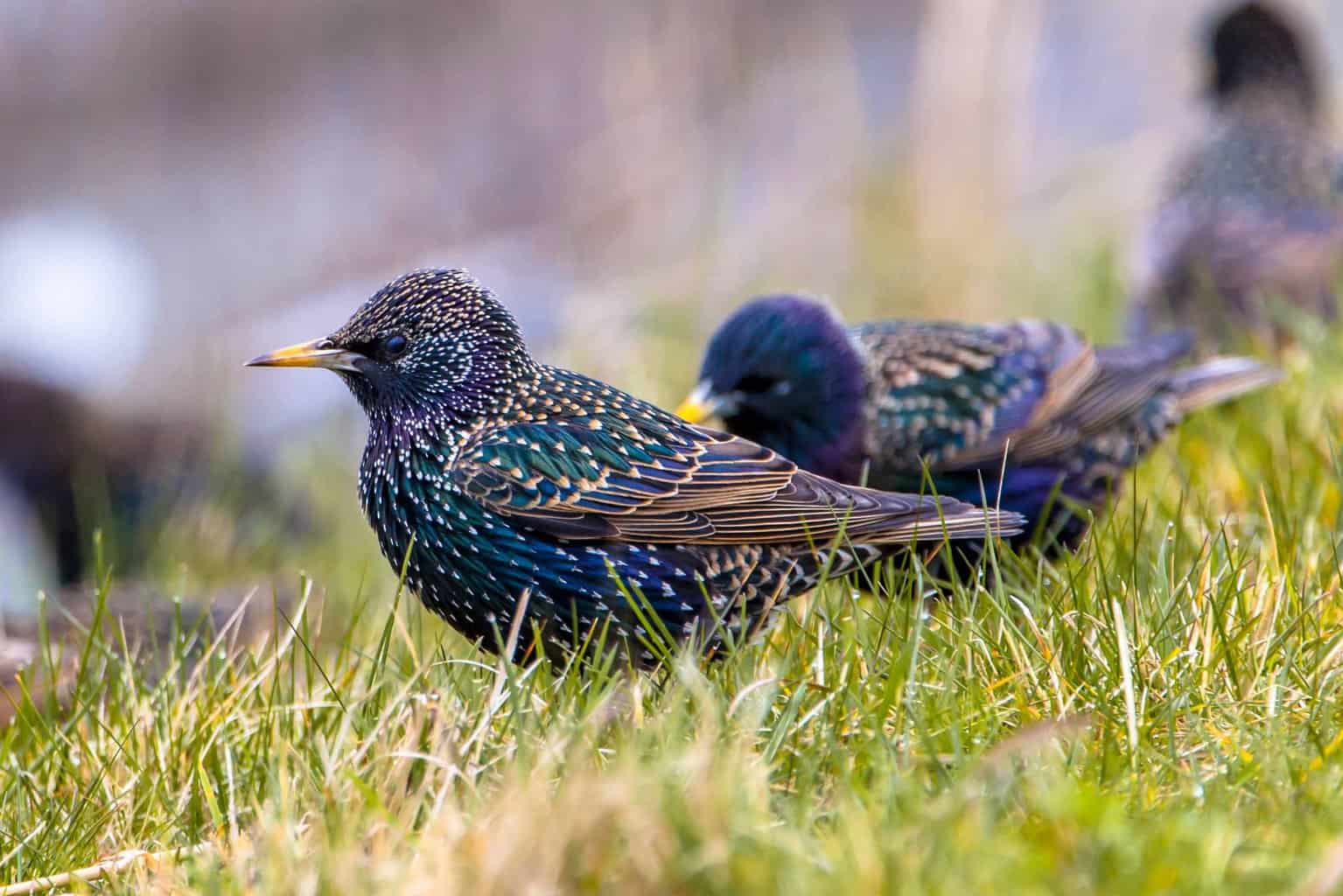If you’ve been out birdwatching and spotted a black bird with a blue head, you might be scratching your head, wondering what it could be.
Interestingly, the combination of dark body feathers with a blue head is more common than you might suppose in the bird world. We’ve dug through more than one thousand North American birds to unearth some fascinating species that display this combination.
While most black-bodied, blue-headed birds are in the blackbird and grackle family, there are a few exceptions. We also came across one bird with a blue body and black head!
We hope this list will help you to identify any birds you see that display this curious color combination. Pay close attention to the ranges and details of appearance given below that could provide the key to a positive ID!
Birds With Black Bodies and Blue Heads in North America
Common Grackle

Probably the most common and well-known black bird with a blue head is the Common Grackle. Significantly larger and nearly double the weight of blackbirds, mature Common Grackles of both sexes have iridescent blue heads, although the males are always brighter than females.
Common Grackles are widespread in all parts of the USA and Canada except for the extreme west and north, and there are significant differences in their appearance between regions.
Birds inhabiting coastal areas have a multicolored iridescent body, whereas interior populations are more bronze-colored. The Florida subspecies also has a beautifully purplish tint to its blue head.
Common Grackles are resourceful birds and opportunistic when it comes to feeding. They’re frequent visitors at backyard feeders, although they prefer to eat from the ground. Check out this video to see what happens when they’re forced to share a platform feeder with Blue Jays!
Great-Tailed Grackle

The largest of North America’s three grackles is the Great-tailed Grackle. It’s only the male, however, that reaches a magpie-like size. The female is smaller, sometimes weighing only half that of the male’s 7-ounce body.
The male also possesses the lion’s share of the color in this species. The sleek purple-blue iridescent covering his entire body only shows up on the wing feathers of the female.
Great-tailed grackles are common and increasing but have a more southwesterly range than the Common Grackle. They’re found year-round from Mexico to Nebraska and only stray slightly further north for breeding.
With their enormous tails and slender upper body, Great-tailed Grackles are extremely beautiful birds. Their noisy, raucous calls and habit of raiding garbage cans, and young bird’s nests, however, has made much of the public ambivalent about these birds!
Boat-Tailed Grackle

The third member of the grackle family is the Boat-tailed grackle. With a native range restricted to the Atlantic and Gulf Coast regions, this species has the smallest distribution of the three.
In our opinion, the Boat-tailed Grackle might just have the most beautiful blue head of all the grackles. It has a more rounded shape and smooth, deep blue iridescence.
Like other grackles, this species roosts and nests in colonies, sometimes numbering hundreds of birds. They have an extraordinary courtship ritual where males puff out their feathers, spread their wings, look up to the sky, and dance around in circles to impress the females!
Because they often inhabit the coastline, Boat-tailed Grackles have a keen appetite for crustaceans and other invertebrates on the shore. Look out for them patrolling beaches at low tide, looking for some tasty snacks!
Purple Martin

Of the 12 swallow species in North America, Purple Martins are the largest. Boasting a wingspan of 18 inches across, males have a deep blue head and dark gray-black body. Females have a blue crown, but a gray forehead, and a gray and brown underside.
Swallows are one of the most skillful and acrobatic flyers in the world. Using phenomenal speed and agility, it’s wonderful to watch them twist and turn in pursuit of the flying insects that make up the bulk of their diet.
Purple Martins are locally common in many regions of the United States and Southern Canada but are most notably absent from most of the Rocky Mountains.
Often taking advantage of the manmade ‘Martin Houses’ that are ideally placed near water, Purple Martins also nest in tree cavities and Saguaro Cactuses.
Brewer’s Blackbird

Besides the grackles, the next best examples of black birds with bluish heads come from their cousins in the blackbird tribe.
The Brewer’s Blackbird is a medium-sized songbird that can be seen anywhere from parking lots to agricultural fields throughout much of North America. While females remain a drab brown throughout the year, the male takes on an impressive glossy hue for the breeding season.
At this time of year, the male’s head often appears purplish rather than blue, but the extremely iridescent feathers change in appearance according to the light. The rest of its body is more of a definite purple color.
Brewer’s blackbird is usually found in small flocks, away from other blackbirds. They forage for insects and grains on the ground. Although they can be rather clumsy at perching, they’ll also sometimes visit backyard platform feeders.
Rusty Blackbird

A less-frequently seen cousin of Brewer’s Blackbird is the Rusty Blackbird. The two species can be hard to tell apart, so we’ll offer you a few tips and tricks to know how!
As their name suggests, both female and non-breeding males of the Rusty Blackbird have a more rusty-colored body than the more grayish Brewer’s species. In breeding season, the male turns a slightly more bluish color than Brewer’s, and this species also has a narrower bill.
Although they share much of the same range as Brewer’s blackbird, they breed further north. Migrating right up to the Hudson Bay and Northern Alaska to nest in Boreal forests, they’re hardly seen in the United States during the summer.
Sadly, these two species of blackbirds are sometimes shot in an attempt to lessen crop damage. What many farmers don’t realize is that these birds also benefit crops by eating pests like weevils, cutworms, termites, grasshoppers, and caterpillars.
European Starling

A controversial bird in North America is the European Starling.
Not a native species to the continent, the European Starling was introduced to New York in the late 1800s. Their population quickly exploded and starlings can now be seen in every US mainland state and much of Canada, too.
It’s during the breeding season that both male and female starlings display their attractive iridescent plumage. Looking like they’ve been dipped in crude oil, their head turns purple and blue while their body becomes green and black.
In winter, European Starlings form huge flocks of thousands of birds. While many would consider the species a pest in North America, few could deny the awesome spectacle of these shape-shifting black clouds that weave wondrous dances through the sky.
Shiny Cowbird

Also in the grackle and blackbird family are the cowbirds.
While all three cowbirds have some iridescent blue and green plumage, it’s only the male of the aptly-named Shiny Cowbird that has a deep blue head set against a dark blue to glossy-black body. Interestingly, this trait is especially pronounced in first-year males who develop the blue sheen on their heads before the rest of their bodies.
Shiny cowbirds were originally from South America and are only a recent addition to the United States. They spread gradually through the Caribbean Islands during the 20th century and arrived in Florida in the 1980s.
Now continuing to spread into neighboring states, flocks of Shiny Cowbirds can be seen in the Southeast foraging on the ground with other members of the blackbird family. Males sing a tropical-sounding gurgling song from the air, trees, or ground.
Tamaulipas Crow

There are a few members of the crow family that have a slightly blue iridescent tint to their feathers, but none more so than the Tamaulipas Crow.
With a sleek, midnight-blue body, the head of Tamaulipas Crow is often the bluest part of their dark bodies.
While a very beautiful bird, Tamaulipas Crow had to come last in our list because they’re only a very occasional visitor from Mexico. Although they were once more common in Southern Texas, they’re now only reported a few times a year.
Like other crows, Tamaulipas Crow is a true omnivore. They’re even sometimes seen alongside gulls and grackles feeding at landfill sites!
A Blue Bird With a Black Head?!
Now we know there are several black birds with blue heads in North America. But are there any species that reverse the trend?
In our mission to unearth all black-headed birds with blue heads, we came across one species that was the exact opposite of what we were looking for!
The Blue Mockingbird is an occasional tropical visitor to Texas, New Mexico, Arizona, and California. With a long tail, long bill, and red eyes, its beautiful blue plumage is only broken by the broad black mask on its face.
Unsurprisingly, the Blue Mockingbird possesses a lush, soothing voice of sweet whistles and warbles. It also frequently imitates other birds, incorporating their songs into its own.
Want To Learn More About Blackbirds?
In this list, we’ve given you a brief glimpse into some of North America’s awesome array of black birds, but there are many more!
Come with us, as we explore a wide variety of black-colored birds in the USA and Canada, including Red-winged Blackbirds, Ravens, and Anis!

